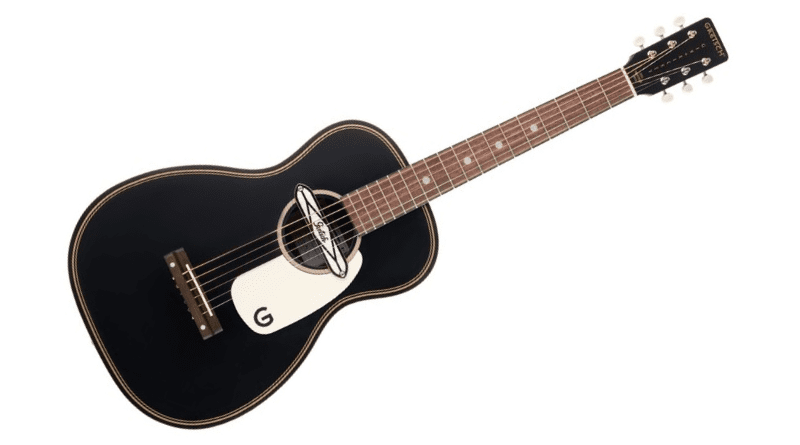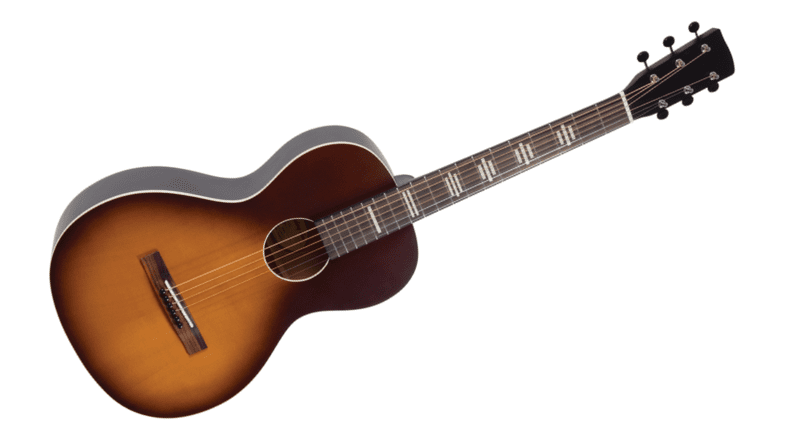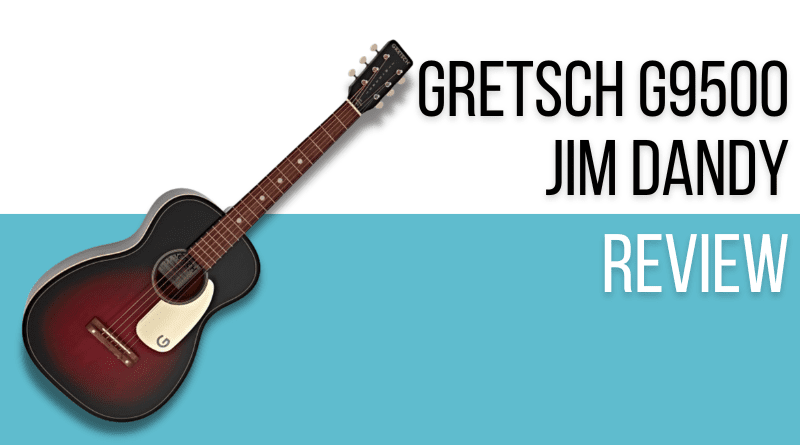Gretsch is well known for their continued use of a vintage aesthetic on their current line up, and the Gretsch G9500 Jim Dandy is no exception to this. It’s got a real classic delta blues vibe about it, both in terms of looks and tones.
One of the most interesting things about the Jim Dandy, however, is that it’s one of the world’s best selling guitars, and in a crowded category like parlor guitars (see our picks here for the best parlor guitars), that’s no mean feat.
So, the question remains, is the Gretsch Jim Dandy still a good choice in a crowded field of excellent parlor guitars? In this KillerGuitarRigs review we spent some time with this awesome little guitar with the intent of finding out. We focused on construction and build quality, as well as tones during the review to establish whether or not it’s a good buy for parlor guitar shoppers.
Read more about our review process.
Contents
Who Is This For?
The Gretsch G9500 Jim Dandy is perfect for guitar players of all levels of ability. The beauty of this guitar is in its simplicity, and as such it’s a really easy guitar to play. It has phenomenal tones that will appeal to blues and roots players, plus, the construction quality is excellent, meaning that it should last for years even with heavy use.
The parlor size makes it a great choice for both smaller and younger players, as well as other guitarists looking for a low cost travel guitar with tons of character.
Appearance / Features / Controls
The Jim Dandy has a retro-inspired look with its vintage sunburst finish and off white pickguard. The body itself was made entirely from basswood, which is a common material on electric guitars, but not so much on acoustics. The reason for the selection of basswood is that it closely mirrors the tonal performance of pine, which was the material of choice for guitars of this type in the 1920s. The benefit of choosing basswood over pine is that basswood is much more hard wearing, resulting in a guitar that lasts much longer.
It had a nato neck, which was carved into a slim to medium C shape profile. It was very comfortable, and we found no issues with fatigue on the left hand after extended play sessions. The fingerboard was made from walnut, and had 18 frets, which were all very well dressed. The nut width was a comfortable 1.6875″ inches, which is a great setup for a guitar of this size.
Interestingly, it didn’t have an adjustable truss rod in the neck, but rather a fixed steel reinforcement. This does mean that there is no way to adjust the neck relief, but we found it to be very well set up from the factory, so it wasn’t much of a concern for us.
The Jim Dandy was fitted with some fantastic open gear die cast tuners that not only looked fantastic, but also delivered strong tuning stability and decent fine tuning, too.
Performance/Sound
We found the sound quality of the Gretsch Jim Dandy to be particularly impressive considering the low price and basswood construction. It was clear and well-balanced, giving off an extremely easy going vibe.
As for where it shines brightest, that would have to be delta blues. It’s not even just the look – the Jim Dandy delivered that unmistakable ’20s tone without skipping a beat. Of course, expectations need to be established that this is not a full bodied dreadnought, and as such it won’t project like one, nor will it have the same presence – but if you’re expecting that from a guitar like the Jim Dandy, you’re looking in the wrong place.
Tonally it was soft and warm, with excellent responsiveness. It played well strummed and fingerstyle, with the latter being our favorite approach for this model.
The Jim Dandy is perfectly at home strumming on the couch, on the porch, around the campfire or on the beach. If you were trying to capture a real vintage tone on a budget, we’d go so far as to say you could get some great results by mic’ing this thing up and recording it.
We got on well with the overall feel – the fretwork was well finished, with no sharps, and everything felt properly leveled. This is always a fear with budget guitars, but thankfully this model seems to be getting the full Gretsch QA treatment.
Other Guitars to Consider
The Gretsch Jim Dandy really is a brilliant option for a parlor guitar, but there are some others out there that are still worth consideration, too. Check out our top alternatives for additional inspiration.
Gretsch G9520E Gin Rickey

If you find that the Jim Dandy isn’t loud enough and you’re looking for something with the same vibe and tones, but with a pickup, make sure to check out the Gretsch G9520E Gin Rickey. This guitar is extremely similar to the Jim Dandy in almost every way, but it features a Gretsch Deltoluxe sound hole pickup.
Played through an amp, the Gin Rickey delivers more of the same gritty blues tones that had us falling in love with the Jim Dandy, but perhaps with even more versatility thanks to the ability to EQ the output.
Recording King Dirty 30s Series 9

The Recording King Dirty 30s Series 9 is another classic delta blues strummer. Like the Jim Dandy, it’s an affordable model, but tonally it’s a little brighter due to its Sitka spruce top, making it a great choice if you find the Gretsch to be a little too dark.
It’s a well built guitar, and it should work well for smaller and younger players, and it should also make for an excellent travel companion.
Final Thoughts on the Gretsch G9500 Jim Dandy
We were absolutely blown away at how much fun the Gretsch G9500 Jim Dandy was to play. It’s not pretentious, nor is it trying too hard to look like a retro guitar – in fact Gretsch has done a wonderful job of making it feel like you’re actually playing a vintage model from the ’20s or ’30s, but perhaps without some of the drawbacks related to having a pine body!
Tonally it was dark and moody, but ever so responsive. It reacted to changes in attack very well, with beautiful warmth and mellow tones when played fingerstyle, and some additional sharpness and grittiness when played hard with a pick.
We can say with absolute certainty that the Jim Dandy is still a great buy, especially when you factor in the sub $200 cost.


